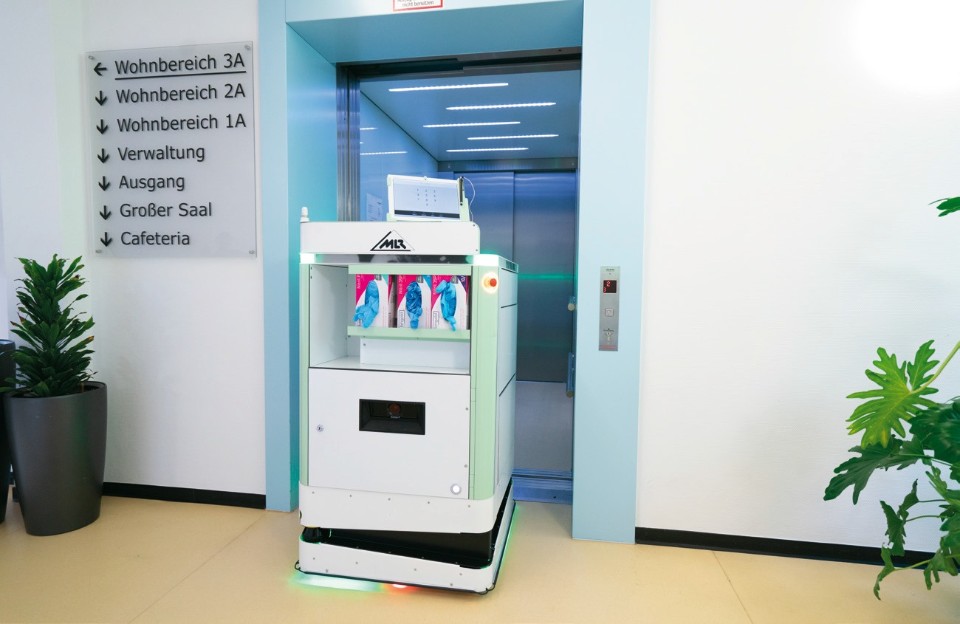
Robots for Assisting with Care Tasks in Nursing Homes and Hospitals

Tabbed contents
Expertise
General information
The care sector is especially affected by demographic change, both in nursing homes and in hospitals. Whereas the number of people in need of care continues to rise, fewer and fewer people entering the employment market are opting to work as care givers. At the same time, older members of the profession are retiring early on account of the high physical and psychological demands of the job. According to a study published in "Der Spiegel" entitled "Which jobs make you ill", the average care giver is off sick for 25 days each year – the third-highest figure among all the occupations covered.
Service robot technologies enable common care aids to be implemented more effectively and ergonomically, therefore making life easier for members of staff as they work. This lowers the number of non-care tasks care givers have to perform and gives them more time to spend on actual care. Also, these advanced care aids can be used to reduce health risks, thus making the job of a care giver more attractive.
Expertise and sample projects
As part of the WiMi-Care project, a comprehensive requirements analysis of a nursing home was made at Fraunhofer IPA and potential service robot applications identified. On the basis of existing robot platforms, scenarios for automated transport, staff support during night shifts, serving residents drinks and for using robots as an entertainment and interactive platform were also implemented.
The aim of the EFFIROB study was to analyze the technical and economic feasibility of new service robot applications. Within the context of residential care, three new scenarios were developed: a versatile transport robot, a partially-autonomous care trolley and a partially-autonomous multi-functional hoist. A prototype of the latter was constructed in the course of the Elevon project. The project SeRoDi concentrates on its further development as well as the product-related implementation of an intelligent care cart and its inclusion in the relevant care process. Initial long-term tests are also being carried out in residential care institutions for the sick and elderly.
Services
Fraunhofer IPA offers support throughout the entire development of new service robot solutions for improving in-patient care – from the concept to prototype construction. A particular focus is on:
- Needs-based market studies and requirements analyses
- Design and development of new assistive care robots in close collaboration with users
- Integration of assistive robotic functions into existing care aids
- Development and implementation of control software
- Compliance with regulatory requirements, e.g. the German Act on Medical Products (MPG)
- Inclusion of the technology in existing or new services and processes
- Real-world evaluations including training courses for designated robot operators
- Transfer of development results to potential manufacturers as a basis for new products
- Support during prototype and serial product development
Project videos

Privacy warning
With the click on the play button an external video from www.youtube.com is loaded and started. Your data is possible transferred and stored to third party. Do not start the video if you disagree. Find more about the youtube privacy statement under the following link: https://policies.google.com/privacyFlexible transport robot for healthcare facilities

Privacy warning
With the click on the play button an external video from www.youtube.com is loaded and started. Your data is possible transferred and stored to third party. Do not start the video if you disagree. Find more about the youtube privacy statement under the following link: https://policies.google.com/privacySupporting the staff in eldercare facilities by exchanging water bottles with Care-O-bot 4

Privacy warning
With the click on the play button an external video from www.youtube.com is loaded and started. Your data is possible transferred and stored to third party. Do not start the video if you disagree. Find more about the youtube privacy statement under the following link: https://policies.google.com/privacyStrategy for approaching a human: Implementation with mobile communication robot “MobiKa”

Privacy warning
With the click on the play button an external video from www.youtube.com is loaded and started. Your data is possible transferred and stored to third party. Do not start the video if you disagree. Find more about the youtube privacy statement under the following link: https://policies.google.com/privacySeRoDi – Service robotics for person-related services